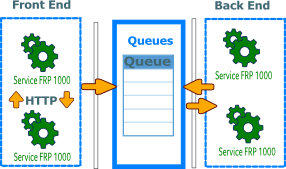MOM architecture (Cloud)
(→Queues) |
|||
| Ligne 23 : | Ligne 23 : | ||
===Queues=== | ===Queues=== | ||
The MOM architecture rely on a set of message queues. | The MOM architecture rely on a set of message queues. | ||
| + | |||
| + | There is an indirection level between the logical queues used by the Application Code and the physical queue used by the MOM architecture. This is defined during the configuration. | ||
Queue are specialized by task nature : | Queue are specialized by task nature : | ||
| Ligne 28 : | Ligne 30 : | ||
{|class="wikitable" | {|class="wikitable" | ||
|- | |- | ||
| − | ! | + | !Logical Queue name |
!Used for | !Used for | ||
|- | |- | ||
| Ligne 48 : | Ligne 50 : | ||
{{tip|Azure infrastructure offers two queue services, Azure Service bus and Azure queue storage. The later is used because of it's better latency.}} | {{tip|Azure infrastructure offers two queue services, Azure Service bus and Azure queue storage. The later is used because of it's better latency.}} | ||
| + | |||
| + | ===Configuration=== | ||
| + | The MOM architecture replace the scheduler and business processes (workflow) available in On Premise deployments. | ||
| + | |||
| + | It must be selected and configured at the Folder level in the administration. | ||
| + | |||
| + | Note that in a multi tenancy deployment the MOM architecture is the only option available because the scheduler service and the Business processes service can't be started. | ||
| + | |||
[[Category:Cloud]] | [[Category:Cloud]] | ||
[[Category:Architecture]] | [[Category:Architecture]] | ||
Version du 27 février 2017 à 10:54
Overview
Because Sage FRP 1000 Cloud solution is based on the concept of separation of a front and back roles, communicating by messages, a new MOM architecture has been developed to implement this concept.
Asynchronous operations
When the MOM architecture is used, the front services execute user actions as asynchronous tasks.
The user action concerned are :
- Application processes which can be scheduled.
- Printing and preview.
- Exporting.
Depending of the user task nature, the asynchronous aspect of the execution may be transparent or not :
- When an action is executed as a transparent asynchronous task, the user has immediately the result.
- When an action is executed as a not transparent asynchronous task, the user as the result in his message box and is notified in the interface of the execution status.
Because transparent asynchronous task require a minimum latency, the queue used for these tasks is separate and listeners used a shorter polling rate.
Queues
The MOM architecture rely on a set of message queues.
There is an indirection level between the logical queues used by the Application Code and the physical queue used by the MOM architecture. This is defined during the configuration.
Queue are specialized by task nature :
| Logical Queue name | Used for |
|---|---|
| TASKP | This queue is used for scheduling of task. |
| TASK | This queue is used for Application processes. |
| USER | This queue is used for transparent asynchronous user actions. |
| This queue is used for print actions. | |
| EVENTS | This queue is used for event processing. |
| Tip : Azure infrastructure offers two queue services, Azure Service bus and Azure queue storage. The later is used because of it's better latency. |
Configuration
The MOM architecture replace the scheduler and business processes (workflow) available in On Premise deployments.
It must be selected and configured at the Folder level in the administration.
Note that in a multi tenancy deployment the MOM architecture is the only option available because the scheduler service and the Business processes service can't be started.
| Whos here now: Members 0 Guests 0 Bots & Crawlers 1 |
